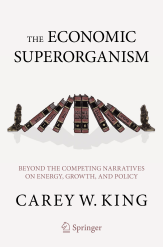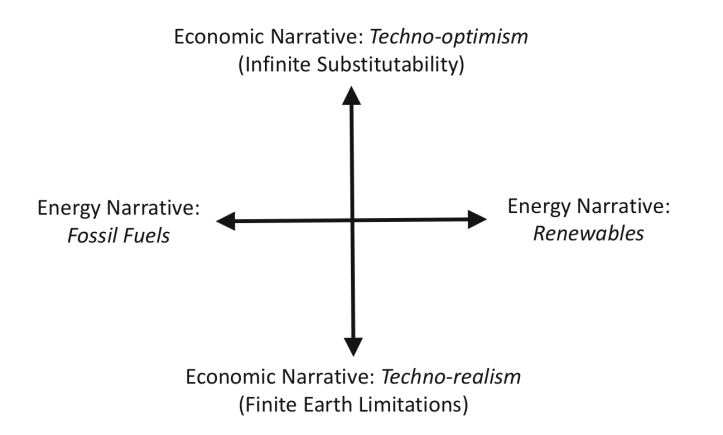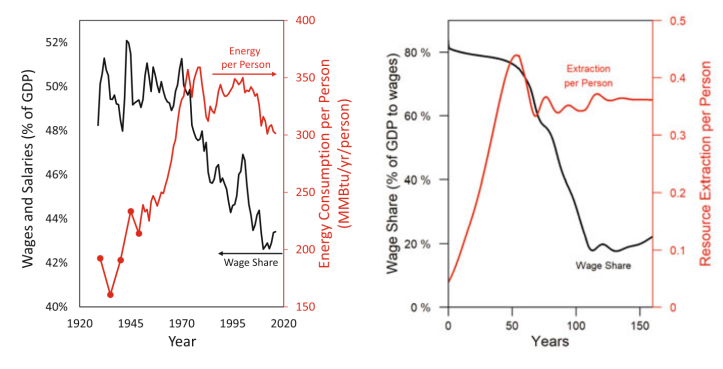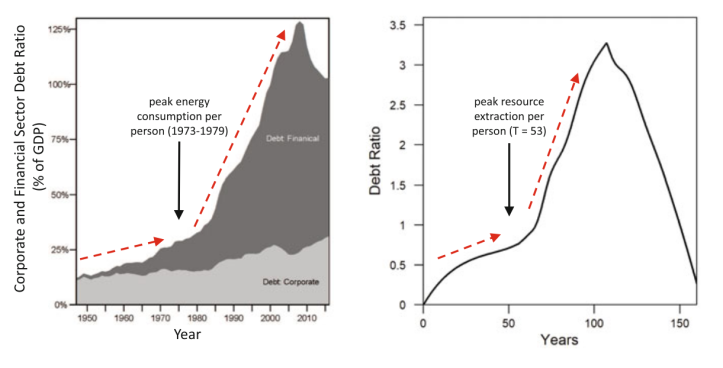From Blair Fix If you are interested in the megatrends of the 21st century, then Carey King’s new book The Economic Superorganism should be on your reading list. It is a well-written, meticulously researched opus on how to understand the sustainability problems that face humanity. In many ways, the book covers well-trodden ground. King is an engineer who is trained in the systems thinking pioneered by MIT engineers Donella and Dennis Meadows. (The Meadows’ book The Limits to Growth was the original gauntlet drop in the debate about the future of economic growth). Like the Meadows, King is concerned with the biophysical limits of the economy, and how that relates to the exploitation of energy. Several other recent books have delved into the role of energy in driving economic growth.
Topics:
Editor considers the following as important: Uncategorized
This could be interesting, too:
tom writes The Ukraine war and Europe’s deepening march of folly
Stavros Mavroudeas writes CfP of Marxist Macroeconomic Modelling workgroup – 18th WAPE Forum, Istanbul August 6-8, 2025
Lars Pålsson Syll writes The pretence-of-knowledge syndrome
Dean Baker writes Crypto and Donald Trump’s strategic baseball card reserve
from Blair Fix
If  you are interested in the megatrends of the 21st century, then Carey King’s new book The Economic Superorganism should be on your reading list. It is a well-written, meticulously researched opus on how to understand the sustainability problems that face humanity.
you are interested in the megatrends of the 21st century, then Carey King’s new book The Economic Superorganism should be on your reading list. It is a well-written, meticulously researched opus on how to understand the sustainability problems that face humanity.
In many ways, the book covers well-trodden ground. King is an engineer who is trained in the systems thinking pioneered by MIT engineers Donella and Dennis Meadows. (The Meadows’ book The Limits to Growth was the original gauntlet drop in the debate about the future of economic growth). Like the Meadows, King is concerned with the biophysical limits of the economy, and how that relates to the exploitation of energy.
Several other recent books have delved into the role of energy in driving economic growth. (For instance, Energy and the Wealth of Nations and The Economic Growth Engine). Yet King’s book is unique, because he has framed his arguments in a surprising way.1 He has focused on narratives.
Energy narratives
Before discussing King’s narrative framework, it’s worth pausing for some reflection. Scientists who study the biophysical limits of the human economy run head-on into a cultural divide between the natural and social sciences. These ‘two cultures’ (as C.P. Snow called them) do not speak the same language.
I can testify to this divide. I have had many frustrating conversations with social scientists who are incredulous that the laws of thermodynamics apply to human societies. (They do.) And I have had equally frustrating conversations with natural scientists (particularly physicists) who insist that there must be a simple equation that describes human behavior. (There is not.)
Reading ‘Superorganism’, I can tell that King has had similar discussions. His response is brilliant. He grounds the hard core of his ideas in the principles of physics and systems science. Yet he frames the debate about these ideas in terms of narratives. The result is a surprisingly non-polemic book that will entice both natural-science and social-science readers.
The linchpin in King’s thesis is the narrative framework shown below — a divide in how we see the future of humanity. Techo-optimists believe there are no inherent limits to growth, because human ingenuity can solve all of our problems. Techno-realists, in contrast, think infinite growth on a finite planet is impossible.

Figure 1: Carey King’s narrative framework.
Today, these opposing worldviews, King observes, play out most prominently in the debate between fossil-fuel advocates and proponents of renewables energy. Fossil-fuel advocates tend to be techno-optimists, while renewable proponents tend to be techo-realists. Looking at the subtleties in these worldviews, however, King notes that they can be technology specific. Renewables proponents are often techo-realists about fossil fuels, but can be techno-optimists about the potential of renewable energy. (This was an ‘aha!’ moment for me … an idea that was suddenly made clear by King’s narrative framework.)
By focusing on energy narratives, King deftly bridges the gap between the natural and social sciences. As a result, there is something in the book for everyone.
Let’s start with people trained in the social sciences. Many social scientists will be intrinsically interested in King’s analysis of narratives. The result (I hope) is that they will be receptive when he weaves into these narratives basic principles of thermodynamics. King’s description of how physicists define and measure ‘energy’, ‘power’, and ‘work’ is among the best I have encountered.
Also interesting to social scientists is King’s fluency with philosophy. Science, King argues, is based on a belief in induction — the idea that we can generalize narrow observations to arrive at universal laws. The philosopher David Hume famously argued that there are no purely logical grounds for using inductive reasoning. Nonetheless, it is how most scientists think.
As an example, King notes that we cannot prove that the laws of thermodynamics hold everywhere. All we can do is show that no experiment has ever contradicted these laws. Scientists therefore assume that the laws of thermodynamics are universal, applying to atoms, animals, and economies. This is the scientific and philosophical underpinning of ‘techno-realism’. It is a worldview based on the cumulative weight of evidence.
Now to what ‘Superorganism’ brings to those trained in the natural sciences. To the natural scientist, the social sciences appear as a dizzying array of mutually conflicting theories that have persisted for centuries. Nothing similar exists in the natural sciences. What’s going on here?
The answer is that in the social sciences, narratives are king. When you look under the hood of many social-science theories (such as neoclassical economics or Marxism), there is little empirical content. Instead, there is a compelling narrative. The adherents of different social-science schools are captivated by the narrative, and the resulting worldview it justifies. By dissecting the narratives around the limits to growth, King gives context to ideas that are otherwise difficult (for the natural scientist) to understand.
A ‘techno-realist’ himself, King does an admirable job of presenting opposing arguments, often letting ‘techno-optimists’ speak for themselves. As a result, ‘Superorganism’ is a veritable compendium of techno-optimist remarks. Here, for instance, is King quoting Milton Friedman on how to tell if a resource is exhaustible:
… economically you have a very simple test of whether anything is an exhaustible resource, namely: is its price rising over time?
Milton Friedman (1978)
King resists the urge to ridicule Friedman’s narrative, but instead patiently breaks down its reasoning and flaws.2
‘Superorganism’ is at its best in Chapter 3, where King applies his narrative framework to the fossil fuels versus renewables debate. Having read this chapter after the recent Texas blackouts, I found it remarkably prescient. King anticipates much of the rhetoric that followed the blackouts. With little evidence, many pundits blamed the grid failure on renewables, which they deemed ‘unreliable’.
King (a Texan himself) anticipates this narrative, and breaks it down by focusing on the concept of ‘reliability’. What we perceive as ‘reliable’ (or not) depends on the time-frame we chose to analyze. Do we mean ‘reliable’ over seconds, minutes, days, years, or decades? Wind, King points out, can be unreliable over the time-frame of days. But it is highly reliable over the time-frame of years and decades. Coal, in contrast, is reliable over days and months. But it is likely to be unreliable over decades (as the resource is exhausted).
King’s patient analysis of the competing energy narratives is a welcome break from the polemics that are common in popular discourse.
The HARMONEY model
In ‘Superorganism’, King’s main technical contribution is his HARMONEY model. This is a systems model similar to the World3 model used in The Limits to Growth. But what is important about HARMONEY is that it incorporates monetary dynamics such as income distribution and debt. Hence the model’s name … HARMONEY … which stands for ‘Human And Resources with MONEY’. (For details about the model, see this paper.)
Figure 2 shows King’s key result. Without tuning it to do so, the HARMONEY model predicts that as resource use plateaus, the wage share of income should decline (top right). It so happens that this is exactly what ocurred in the United States. As energy use (per person) plateaued, the wage share of income plummeted (top left). HARMONEY also predicts that after resource use peaks, debt (as a share of GDP) should explode and then later peak (bottom right). Again, the model’s prediction is eerily similar to US history (bottom left).


Figure 2: Results from King’s HARMONEY model. Top left: the wage share of income in the US declined as energy use per person plateaued. Top right: King’s HARMONEY model predicting the same phenomenon. Bottom left: The growth and peak of US corporate and financial debt. Bottom right: King’s HARMONEY model predicting the same phenomenon.
Of course, if you are familiar with modeling, you know that just because a model gives ‘good results’ does not mean that it is ‘correct’. The assumptions behind the model must also be consistent with evidence. Given HARMONEY’s intriguing results, I’ve marked it on my to do list to have a good look at the model’s foundations.
One more thing to mention is that HARMONEY does not use an aggregate production function. This is important, because there are many problems with such functions. Perhaps the most glaring flaw is that the standard production function (the Cobb-Douglas) is a tautology. It is a rearrangement of a national accounting identity. Hence, when systems modelers use such a function, they undermine what may otherwise be a sound model.3 By not using a production function, HARMONEY avoids this mistep.
The economy as a ‘superorganism’
To move beyond the competing narratives about energy and the economy, King suggests we adopt a new narrative — ‘the economy as a superorganism’. I have mixed feelings about this metaphor.
The ‘superorganism’ narrative works well for emphasizing the biophysical nature of the economy. Like an organism, human societies use resources to maintain and grow their structure. That’s a nice way to emphasize biophysical constraints on the economy.
Where the superorganism narrative falls short, however, is that it tends to downplay conflict. Yes, humans do cooperate much like the cells within organisms. But we also fight. We commit crime. We exploit one another. We go to war. True, there is conflict within organisms — for instance between cancer cells and the immune system — but it is a poor allegory for human conflict.
We can improve the superorganism narrative, I think, by making two changes. First, we switch from singular to plural — superorganism to superorganisms. This switch to plural emphasizes that there is competition between human groups. Today, we (arguably) have a single world economy. But this is a historical anomaly. Throughout most of history, there were many competing factions of humanity — competing superorganisms.
Second, we should place these human superorganisms in the context of major evolutionary transitions. The effect of doing so is to emphasize internal conflict. The major evolutionary transitions, if you’re not familiar, are leaps in how life organized. Life began, presumably, as self-replicating molecules. Somehow these molecules transitioned into organizing in groups of proteins and DNA. From these proteins came prokaryotic cells, which later merged to form eukaryotic cells. These eukaryotes then grouped together to form multi-cellular organisms. And finally, some multi-cellular organisms began to organize in large groups, paving the way for the first ‘superorganisms’.
What’s important about these major transitions is that they all involve suppressing competition. Autonomous agents that once competed with one another (cell vs. cell, animal vs. animal) evolved to cooperate. The degree to which there is cooperation (rather than competition) is the degree to which a new ‘individual’ emerges. In other words, we conceive of multicellular organisms as ‘individuals’ precisely because there is so little competition between the constituent cells. The human transition to ‘superorganism’, in contrast, is far less complete. There remains rampant conflict within human groups. Placing human ‘superorganisms’ within the context of major evolutionary transitions acknowledges this internal conflict.
To be fair, King does adopt an evolutionary framework in his discussion of the economic superorganism. But he focuses on the gene-meme approach promoted by Richard Dawkins and Daniel Dennett. My opinion is that the human transition to ‘superorganisms’ is better understood using the theory of multi-level selection and cultural evolution proposed by David Sloan Wilson and Peter Turchin (among others).4 I won’t split hairs, however, as a book review is not the place to debate basic tenets of evolutionary biology.
A bitter pill
Speaking of evolutionary thinking, it is when considering neoclassical economics from an evolutionary standpoint that King is most poignant. Could it be, he asks, that “economies organized via neoclassical economics are more fit … than those organized via other economic systems and rules”? King shudders at the possibility:
For me, it is a bitter pill to swallow to even contemplate that this hypothesis might be true. I never imagined I would write that neoclassical economics might have some enhanced usefulness over more biophysically based approaches to economic modeling. At this time, neoclassical economics is clearly the most pervasive economic meme. As a cultural construct, it is winning the evolutionary game of self-replication.
This is indeed a bitter pill … one that I have been forced to swallow myself.5 Fortunately, admitting that neoclassical economics is winning the game of evolution does not require a scientific concession. That’s because false ideas often beat out true ones. (Hence the success of Donald Trump.) For this reason, evolutionary biologist David Sloan Wilson argues that successful belief systems are often “massively fictional in their portrayal of the world.”6
In the game of evolution, Wilson observes, it is not a belief system’s scientific veracity that matters. What’s important is its affect on human behavior. If those who hold worldview X outcompete people with worldview Y, worldview X spreads. Only in rare circumstances, however, will worldview X be the same as the scientific truth. That’s because the scientific truth is singular, but the range of possible worldviews is practically infinite.
Back to economics. For those of us who are concerned with sustainability, it’s worth speculating about why neoclassical economics has spread. To do so, we can return to King’s narrative framework (Figure 1). Neoclassical economists tend to be ‘techno-optimists’ who believe that economic growth can continue indefinitely. And it’s easy to understand why they hold this worldview: the neoclassical model omits the biophysical basis of human society.
In a full world, this omission is likely to be suicidal in the long run. But neoclassical economics did not originate in a full world. It originated in an empty one.7 In this empty world, it was the societies that expanded the fastest that won. Now think of the cultural differences between the winners and the losers. The winners were Europeans, who pursued imperialist policies with no regard for the inhabitants (human or otherwise) of the regions they conquered. The losers were indigenous populations, who were keenly aware of resources limits.
In the (over)full world towards which we’re headed, my guess (hope?) is that neoclassical economics will become a losing belief system. The question is, what will replace it? King hopes (as do I) that it will be replaced by a biophysical understanding of the economy. On that front, King’s book, with its focus on narratives, is a step in the right direction. That’s because when it comes to belief systems, narrative is king.
The energy conversation
King’s ‘Superorganism’ is an important contribution to the sustainability discussion. It helps make sense of the competing worldviews that dominate political debates, while also highlighting the physical principles that govern human economies.
On the final page of ‘Superorganism’, King writes:
Too often people use the energy and economic narratives to speak past each other rather than engage in thoughtful conversations on these tradeoffs.
I hope this book better enables these conversations.
In the on-going discussion about sustainability and energy, people will likely continue to speak past each other. Still, for those who are willing to listen, King’s book is a welcome addition to the conversation.
